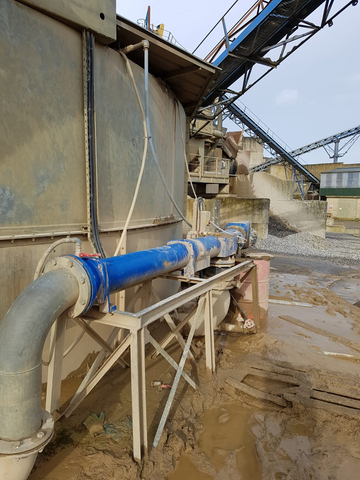Irish Site Reaps The Benefits Of An Lsm 100 Peristaltic Pump

Fogarty Concrete have concrete processing plants in County Tipperary and County Laois and provide concrete products throughout Ireland.
Fogarty Concrete’s County Tipperary site had been using a screw pump to pump their silt return; however, the pump kept having to be emptied due to ongoing issues with clogging.
As a result, the area surrounding the screw pump would fill with sludge and pose a danger to employees. This resulted in downtime while the area was cleaned. Further downtime would come from the need to frequently replace parts and undertake general maintenance.
During a site visit, owner Andy Fogarty brought the matter to the attention of Atlantic Pumps’ representative for Ireland, Kelvin Glass. After viewing the current pump set-up and the issues the site faced, Kelvin recommended an LSM 100 peristaltic pump.
LSM pumps are known for their low energy consumption, low and easy maintenance and their exceptional build quality. These self-priming, high pressure pumps are able to run dry, are reversible and have the ability to pass large objects.
We initially supplied Fogarty Concrete with the LSM 100 on a two week hire and, following a hugely successful trial period which saw a reduction in downtime and removed the need for the pump to be unblocked, Fogarty Concrete purchased the LSM 100 peristaltic pump without hesitation.

Talking about the LSM 100 at Fogarty Concrete, Kelvin said “After visiting the site once the installation had been successfully completed, a number of the sites employee’s commented about the difference the pump had made to the process, and how there were none of the headaches that the previous pump had caused”.
One month on and the pump continues to perform without issue.
Key reasons why we would recommend an LSM 100 for a thickener underflow application:
- The pump is seal-less therefore there will be no leakage keeping the area clear of spillages.
- The only wearing part is the hose, and in this sort of application it would often last at least a year. When it comes to changing it the hose it is very simple compared to a refurbishment of a centrifugal pump.
- On a CDE thickener tank they often have a valve system to dilute the slurry with water to make it possible to pump. A peristaltic can pump a much higher solids percentage, removing the need for dilution. This means you are losing less clean water back to the lagoons or to the centrifuge.
- The pump can be mounted outside the footprint of the thickener tank due to the suction capacity of the pump, making access easier.
- The pump can be run backwards which is useful when you need to unblock rakes or valves.
- Most centrifugal pumps in this application would have roughly a 30-37kW motor, whereas the LSM has a 15kW motor, hence reducing running costs.
- The pump is run with an inverter, so if feed rate needs to be variable between two options e.g. lagoon and centrifuge, then the flow can very easily be adjusted.



